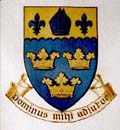|
This text, courtesy of Mike Skivington.
In 1615 six monks from Dieulouard came to Paris and set up what was at first a Benedictine house of studies. The first superior was Dom Augustine Bradshaw. The monks moved a number of times ending up in the Rue St. Jacques. Forty one years elapsed before the community obtained full recognition as a monastery (1656) and a further eighteen passed before foundations of a new church and monastery were laid (1674) and the older buildings started to be demolished. Some monks from St Edmunds went on the mission and others from Dieulouard and Douai stayed at St Edmund's while studying at the Sorbonne but gradually a more permanent community emerged.
Anne of Austria, Queen Mother and Regent of France, ordered that the monks
should receive a copy of every book published in Paris Her son Louis XIV
issued the letters of establishment that gave the community permission
to own property in their own name (previously the property was held in
the name of a French subject). Later the king donated money to the houses
of the EBC and issued letters of naturalization to the monks, which in
turn meant that the priory, as it was, could collect an income from other
priories and parishes. Further royal connections were established when
the deposed King James II of Great Britain visited St Edmund's at least
four times and both he and his young daughter were interred in the church.
A Requiem Mass was celebrated for his grandson "Bonnie Prince Charlie".
The monks were visited by many prominent Jacobites and also by Dr Samuel
Johnson. There is an oral tradition that Benjamin Franklin wrote the preface
to the American constitution while staying at St Edmund's. The proximity
of the Sorbonne and the presence of monks from other monasteries living
at St Edmund's whilst studying at that university, lead to high academic
standards. Fr. (Later Vicar Apostolic ) Charles Walmesly was a mathematician
and astronomer who was a member of the Royal Society and advised the British
Government on the introduction of the Gregorian Calendar. Bro Benet Weldon's
"Life of James II" is now in the British Library. A "Society
of St Edmund" based its rules on those of the Royal Society and provided
regular lectures on a wide range of subjects. The size of the premises
did not permit the development of a school but there was one at the dependent
priory of La Celle.
Fr. Henry Parker was elected prior in 1789, just before the outbreak of
the French revolution. In 1793 the monks were imprisoned in their house
and later in jail. They were allowed to return to their home in 1795 but
saw the need to move out of the city. Prior Parker died before the monks
found a new home and in his will he asked Dom Richard Marsh a previous
Prior of Dieulouard to look after the interests of the dwindling community.
|
